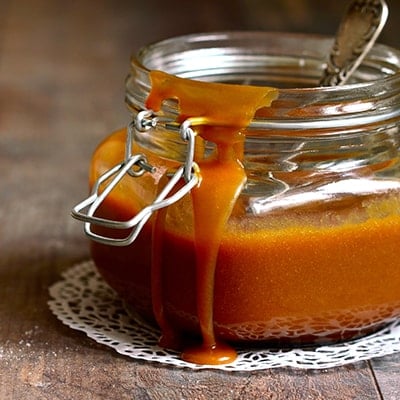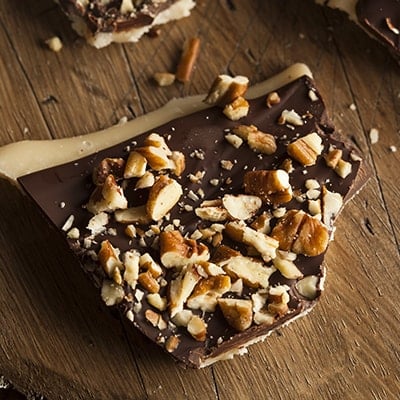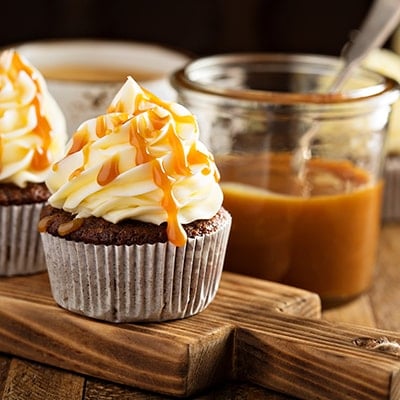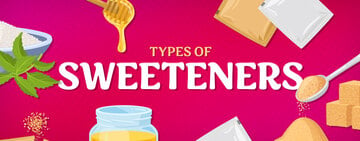What Is the Difference Between Toffee, Caramel, and Butterscotch?
Toffee, caramel, and butterscotch are three classic desserts. From butterscotch sundaes to decadent English toffee, each features an irresistible combination of sugar and butter. Whether you operate an ice cream shop, bakery, candy store, or catering company, it’s important to understand the difference between butterscotch, toffee, and caramel. Keep reading below to learn more about each type and how to make them.
Shop All Candy Making SuppliesToffee vs Caramel vs Butterscotch
Read below to understand their unique differences:
What Is Butterscotch?
Butterscotch is butter and brown sugar that has been slowly heated together to create a soft-crack candy. Just like caramel, the brown sugar molecules break down and, thanks to the addition of molasses in the sugar, caramelize into a richer, deeper flavor than classic caramel.
To create a sauce, topping, or candy, additional ingredients like vanilla, salt, and cream can be added once caramelization has occurred.
What Is Caramel?

Caramel is white granulated sugar that's been heated slowly to 340 degrees Fahrenheit. This gradual heating process breaks down the sugar’s molecules and creates a deep golden brown color and rich flavor.
While caramelization can be achieved by simply heating sugar, other ingredients including butter, milk, and vanilla are often added afterward to produce a thick, creamier caramel used in sauces, drizzles, candies, and classic caramel apples.
When creating caramel, there are typically two different versions: wet caramel and dry caramel. Wet caramel refers to caramel that has been made by adding water to the sugar during the heating process. Adding water can help to distribute heat evenly across the mixture to prevent burning and crystallization. Dry caramel simply refers to sugar caramelized without water added.
Butterscotch vs Caramel
The difference between butterscotch and caramel is that caramel is made with white granulated sugar and cooked to 340 degrees Fahrenheit, whereas butterscotch is made with brown sugar and cooked to 289 degrees Fahrenheit. Both are often enhanced with additional ingredients to alter the texture, taste, or consistency depending on their intended purpose or the recipe used to make them.
What Is Toffee?

Toffee is butterscotch that has been cooked for a longer period of time. Toffee begins as a base of butter and brown sugar that is gradually cooked to the hard-crack sugar stage between 295 and 309 degrees Fahrenheit.
Toffee vs Butterscotch
While butterscotch is cooked to a soft-crack stage, toffee is produced by allowing that same butter and brown sugar mixture to reach the hard-crack stage. Butterscotch tends to be chewy and pliable; toffee is brittle and more breakable.
Toffee vs Caramel
The difference between toffee and caramel is that caramel is made with white granulated sugar and cooked to 340 degrees Fahrenheit, whereas toffee is made with butter and brown sugar and cooked to 295 - 309 degrees Fahrenheit.
Back to TopSugar Stages Temperature Comparison
When sugar is boiled, the concentration of sugar molecules increases as water is evaporated. The longer sugar cooks, the higher the sugar concentration becomes. This sugar concentrate is what creates the varying stages of sugar.
The comparison list below outlines the most common sugar temperature stages needed to achieve each stage.
Thread
- Example of Candy: Syrup
- Temperature (in Degrees Fahrenheit): 230 to 234
- Percentage of Sugar Concentrate: 80%
Soft Ball
- Example of Candy: Fudge
- Temperature (in Degrees Fahrenheit): 234 to 241
- Percentage of Sugar Concentrate: 85%
Firm Ball
- Example of Candy: Soft Caramel
- Temperature (in Degrees Fahrenheit): 244 to 248
- Percentage of Sugar Concentrate: 87%
Hard Ball
- Example of Candy: Gummies
- Temperature (in Degrees Fahrenheit): 250 to 266
- Percentage of Sugar Concentrate: 92%
Soft Crack
- Example of Candy: Butterscotch
- Temperature (in Degrees Fahrenheit): 270 to 289
- Percentage of Sugar Concentrate: 95%
Hard Crack
- Example of Candy: Toffee
- Temperature (in Degrees Fahrenheit): 295 to 309
- Percentage of Sugar Concentrate: 99%
Light Brown
- Example of Candy: Flan or caramel cages for decorating
- Temperature (in Degrees Fahrenheit): 320
- Percentage of Sugar Concentrate: 100%
Brown Liquid
- Example of Candy: Caramel
- Temperature (in Degrees Fahrenheit): 340
- Percentage of Sugar Concentrate: 100%
Burnt
- Example of Candy: N/A
- Temperature (in Degrees Fahrenheit): 351
- Percentage of Sugar Concentrate: 100%
Back to Top
How to Make Caramel
The trick to making caramel is to constantly stir the sugar while slowly and gradually heating the mixture. This keeps sugar crystals from burning instead of caramelizing.
There are many different varieties of caramel, but this recipe can be used to create a caramel sauce or drizzle that's perfect for topping sundaes, cakes, and other desserts.
Caramel Recipe
Cook Time: 30 minutes
Cool Time: 10 minutes
Total Time: 40 minutes
Caramel Ingredients:
- 3 cups white sugar
- 6 Tablespoons unsalted butter
- 1 1/2 cups heavy cream
- Pinch of salt, or 2 teaspoons of salt to make salted caramel
Caramel Directions:
- Place sugar into a pan on medium heat.
- Watch the sugar on edges of pot begin to turn to liquid.
- Using a heat-resistant spatula or spoon, stir sugar every few seconds. Be sure to scrape the bottom of the pot for any bits that may start to stick.
- Continue to stir as sugar clumps together in large lumps and begins transitioning into a golden-colored liquid.
- Stir constantly until the clumps are gone and the sugar is now completely liquid.
- Turn the heat off as you carefully add in the butter. Use a spoon or spatula if possible, as the butter will cause the caramel to bubble up when added.
- Stir in butter for two minutes.
- While stirring, carefully pour the cream into the mixture. Once fully combined, remove the pot from the stovetop and allow to cool.
- Serve immediately or store in jars and refrigerate for future use.
Back to Top
How to Make Butterscotch

Butterscotch’s main ingredients include butter and brown sugar, but the addition of some heavy cream and vanilla extract makes it perfect for topping sundaes and other sweet treats in your kitchen.
Butterscotch Recipe
Cook Time: 35 minutes
Cool Time: 10 minutes
Total Time: 45 minutes
Butterscotch Ingredients:
- 6 Tablespoons unsalted butter
- 2 cups dark brown sugar
- 1 1/2 cups heavy whipping cream
- 1 Tablespoons vanilla extract
- Pinch of sea salt
Butterscotch Directions:
- Using a heavy-bottomed pot, melt butter over medium heat.
- Once butter has melted completely, add brown sugar and stir until sugar is completely coated.
- Watch mixture closely and stir occasionally for three to five minutes. Be sure to scrape the bottom and corners of the pot to prevent clumps from burning. The mixture should turn from grainy and lumpy to smooth and bubbly.
- Using a whisk or rubber spatula, carefully pour in the heavy cream, lower the heat, and stir until cream has been completely mixed in.
- Turn the heat back up to medium and continue to stir occasionally until the desired color and a thick, smooth consistency are reached, about 10 minutes.
- Remove from heat and allow mixture to cool slightly.
- Stir in vanilla extract and sea salt. If the butterscotch is cool enough, taste as you go, and add more vanilla and salt if needed.
- Serve immediately or store in refrigerator for later use.
Back to Top
How to Make Toffee
To make toffee, follow the directions above to make butterscotch. In addition, you’ll want to use a candy thermometer to track when your butterscotch-to-toffee reaches the hard crack stage, which is around 300 degrees Fahrenheit.
Toffee is often combined with nuts such as almonds and semi-sweet chocolate to create classic English toffee. This is done by spreading the hot toffee out flat over a sheet pan and topping it with semi-sweet chocolate chips. Allow the chips to melt for about 30 seconds and carefully use the back of a spoon to spread the chocolate over the entire top of the toffee. Top with chopped or slivered almonds. Allow the English toffee to cool for about 3 hours before breaking it into small pieces.
Back to TopTips for Making Caramel, Butterscotch, and Toffee
While the three may differ in taste and texture, the methods used to cook them are similar. To produce decadent-tasting sugars, be sure to keep the following tips in mind:
- Never step away from the sugar when it’s cooking. It only takes a few seconds of neglect for sugar to burn.
- Do not try to touch or taste the sugar while it’s cooking, it will be extremely hot and sticky.
- Cook your mixture in a larger pot than you think is necessary because the sugar can produce large bubbles as it turns into a liquid or additional ingredients are added.
- Opt for a stainless steel pot to best handle the high temperatures. Some non-stick coatings may be affected by the hot sugars.
- When making caramel, wait to add ingredients such as cream and butter until after the caramelization process has occurred.
- Squeezing a small amount of lemon juice into your sugar while it’s cooking can help prevent crystallization.
- Keep ice water on hand in case you accidentally come into contact with the hot sugar.
Back to Top
While some may think caramel, butterscotch, and toffee taste the same, any candy connoisseur knows each of these delectable sweets has its own unique flavor, texture, and consistency. And now that you know the difference, you can confidently create and serve customers the best sugar candy in your candy store.



